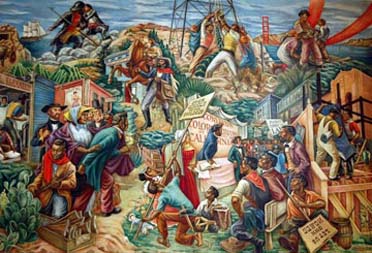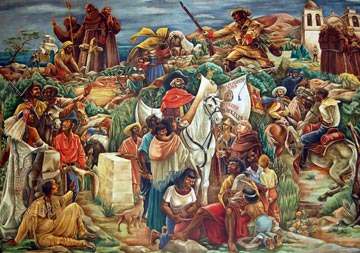The City’s Office of Historic Resources (OHR) has announced that Los Angeles has reached a major Preservation Milestone: Historic-Cultural Monument No. 1000 has been designated. The following article is reprinted from the OHR newsletter:
On June 1, 2011, the City of Los Angeles reached a significant milestone in its historic preservation program: the approval of City Historic-Cultural Monument No. 1000, the Golden State Mutual Life Insurance building at 1999 West Adams Boulevard in West Adams.
The Golden State Mutual Building is a very fitting recipient of this honor. Built in 1949, this six-story commercial building was designed in the Late Moderne style by architect Paul R. Williams (1894-1980). Williams was the first certified African American architect west of the Mississippi River, the first African American member of the American Institute of Architects, and also served on the first Los Angeles Planning Commission in 1920.
 |
 |
| The Negro in California History — Settlement and Development Artist: Hale Woodruff |
The Negro in California History—
Exploration and Colonization Artist: Charles Alston |
THE GOLDEN STATE MUTUAL BUILDING IS HOME TO TWO IMPORTANT CULTURAL HERITAGE LANDMARKS
The interior lobby of the building was designed to incorporate two integrated murals, one for each sidewall. These large Social Realist style murals, The Negro in California History—Exploration and Colonization by artist Charles Alston and The Negro in California History —Settlement and Development by artist Hale Woodruff, are together a panoramic depiction of African American history in California from 1527 through 1949. Building architect Paul Williams sat on the three-person committee that selected the murals’ artists and subject.
The Golden State Mutual building draws on a rich history of integrated murals in buildings. Whether the mural is painted directly onto the wall surfaces or onto canvas that is then affixed to a specifically designed space, the result is a building with integrated artwork that serves to enhance both the architectural setting and the public experience.
The murals at Golden State Mutual, which are painted on canvas, are part of the building’s original design as conceived by architect Paul Williams and remain in good condition with high integrity. They represent a significant interior element of the building, with their depictions of African American history in California. The mural dedication ceremony on August 19, 1949, served as the official opening of the building and commenced a series of events that ended with the dedication of the building on August 23 of the same year.
Artists Charles Alston and Hale Woodruff were each commissioned to create expansive murals depicting African American heritage in California that would become integral components of the lobby of Golden State Mutual’s new building.
Charles Alston (1907-1977), a noted African American artist who worked in the mediums of painting and sculpting and served as an art educator, was known for “fusing modern art styles with non-Western influences to create a new and distinctive African American idiom.” Alston was influenced by the largescale works of the Mexican muralists, including Diego Rivera and Jose Clemente Orozco. One of Alston’s early works of this form was a large pair of murals for New York’s Harlem Hospital entitled Magic and Medicine and Modern Medicine, which were funded by the Works Progress Administration and celebrated African American heritage in the field of medicine.
Hale Woodruff (1900-1980) had a distinguished career as an artist and art educator. His first mural was created in 1934 in collaboration with artist Wilmer Jennings as a Public Works Project and celebrated African American contributions to wide ranging aspects of America’s cultural traditions. The four-panel mural was titled The Negro in Modern American Life, Literature, Music, Agriculture, Rural Life, and Art. Like Alston, Woodruff had an interest in the mural painting traditions of Mexico. He studied directly with Mexican muralist Diego Rivera in 1936 and “noted the parallels between Mexican art and that of African Americans.”
Founded in 1925, Golden State Mutual Life Insurance Company (“GSM”) made history as the first African American owned insurance company to be established west of the Mississippi. As the company grew and developed over the years, GSM increased in prominence, becoming a central figure in the development of African American businesses in America.
On July 23, 1925, William Nickerson, Jr., Norman Oliver Houston, and George Allen Beavers, Jr. opened the Golden State Guarantee Fund Insurance Company in a one-room office above a Central Avenue storefront in South Los Angeles. Nickerson had relocated from Houston after founding the American Mutual Benefit Association, the first black insurance company in Texas. Hoping to create an integrated insurance company that would serve numerous states, Nickerson joined Houston, a Northern Californian, and Beavers, who came to Los Angeles from Atlanta as a child, to realize his dream.
With undercurrents of discrimination, then-existing insurance companies denied coverage to California’s estimated 40,000 African American families for being “uninsurable” or “extraordinary risks.” In the local African American community, Golden State rapidly filled a huge void. By 1928 it had over 100 employees, including 60 agents, with branches in Pasadena, Bakersfield, San Diego, and Fresno. By 1930 it employed 130 African Americans in white-collar positions. It was renamed Golden State Mutual Life Insurance Company (GSM) in 1931. Remaining profitable and paying dividends throughout the Depression, by the end of the 1930s GSM had six million dollars in policies and assets of $437,000.
By World War II, GSM had added branches in Illinois and Texas. The firm constructed its first headquarters building in 1929, a Spanish Colonial Revival style building located at 4261 S. Central Avenue that was designed by noted African American architect James H. Garrott.
In 1945, Nickerson died, and was succeeded by Norman Houston as president of GSM. At the time, Golden State was already the largest black-owned business of any type west of the Mississippi River. Houston oversaw GSM through phenomenal growth during the postwar era, and orchestrated its relocation to Los Angeles’ West Adams district.
Houston hired famed African American architect Paul R. Williams to design what became its iconic headquarters building. The groundbreaking for GSM’s new Home Office on the northeast corner of Adams Boulevard and Western Avenue took place on March 31, 1948. A Los Angeles Sentinel article about the groundbreaking described the Late Moderne tower as “…the finest building to be erected and owned by Negroes in the nation.” Among the famous and influential people present the next year at its August 23, 1949 opening were Mayor Fletcher Bowron, Lieutenant Governor Goodwin J. Knight, and the California Eagle’s owner, Charlotta Bass. The building was GSM’s headquarters for 60 years, from 1949 to 2009.
Located at 1999 West Adams Boulevard, the Golden State Mutual Life Insurance Company Home Office is a Late Moderne style building with a six-story central core flanked by two five-story wings arranged symmetrically and projecting at 45-degree angles from the main entrance elevation. Atop the canopy are freestanding edge-lettering in Moderne-styled stainless steel block letters spelling “GOLDEN STATE MUTUAL LIFE.”
Inside, the double-height lobby features round-cornered walls and a curved full-length balcony at the mezzanine level. The lobby’s rear wall is clad in full-height birch wood paneling. A flat, birch wood belt course runs continuously along this paneling and its curved corners. The lower portions of the lobby’s side and front walls are clad in travertine marble paneling. The floor is clad in dark green verde terrazzo, which extends a short distance up the wall plane as coping.
The upper portion of either lobby sidewall has affixed, oil-on-canvas murals, each 16’5” long and 9’3 1/4” tall. The west wall mural, painted by Charles Alston, depicts The Negro in California History—Exploration and Colonization, of events in African American history from 1527-1850. The east wall mural, painted by Hale Woodruff, depicts The Negro in California History—Settlement and Development, of events in African American history from 1850-1949.
Until it closed its doors in 2011, Golden State Mutual was the largest black-owned insurance company in the western United States for most of its existence. More importantly, GSM literally changed the landscape of Los Angeles. The company made life insurance widely available to tens of thousands of its African American citizens, and in constructing the GSM Home Office in West Adams, the company expanded black enterprise and residency in Los Angeles. A 1978 company history sums up the present-day historic significance of the Golden State Mutual Life Home Office, that it “Stands today as a symbol of black enterprise and of loyal service to many thousands.”
For a comprehensive review of the preservation efforts behind this Landmark's designation, click here to download the 2011 February Newsletter.
